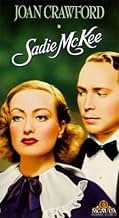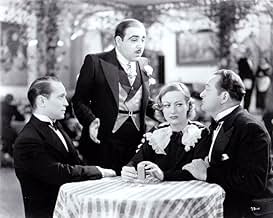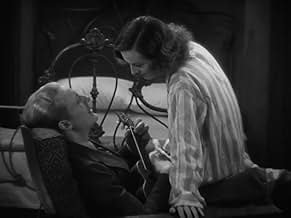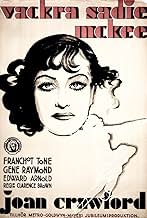IMDb RATING
6.8/10
1.8K
YOUR RATING
A working girl's fortunes improve when she marries into money, but happiness is not so easily won.A working girl's fortunes improve when she marries into money, but happiness is not so easily won.A working girl's fortunes improve when she marries into money, but happiness is not so easily won.
- Director
- Writers
- Stars
- Awards
- 3 wins total
Leo G. Carroll
- Phelps
- (as Leo Carroll)
Candy Candido
- Cafe Entertainer
- (as Candy and Coco)
Otto Heimel
- Cafe Entertainer
- (as Candy and Coco)
Hooper Atchley
- Intern with Dr. Briggs
- (uncredited)
Nellie Bly Baker
- Downstairs Laundress
- (uncredited)
Jack Baxley
- Short-Order Cook
- (uncredited)
- Director
- Writers
- All cast & crew
- Production, box office & more at IMDbPro
Featured reviews
Well-made Clarence Brown pre-Code soaper with Joan Crawford (Brown directs Joan 5 times) costumed by Adrian (he does this a total of 28 times) and photographed by Oliver T. Marsh (he did a total of 15 films with Joan). First class production crew yields a first class film.
Joan plays a `shopgirl' character that could have had no heart (Barbara Stanwyck would have excelled at such an interpretation) but the writers gave her an innate goodness that warms Sadie McKee to her audience. Edward Arnold stands out as the drunken millionaire that must have served as a role model for Dudley Moore years later in `Arthur.' His sock in the jaw to Joan is unexpected and looks very real. Gene Raymond does well as the love interest and if that was he singing he did it well. His final scene is very good and somewhat unusual. Franchot Tone does not appear to have had the opportunity to develop his character sufficiently to make him more effective. It must have been good enough, because he got Joan after the film was completed. A somewhat zaftig Esther Ralston still manages to demonstrate why she was `The American Venus' and why Raymond spent so much of his time smiling. Why her character does not react to Raymond singing a love song to Joan in the Apollo Theater is beyond me. Leo G. Carroll does a superb job as the butler his distain for the lower class Joan is great.
Joan's character has many choices in this film and she generally comes out ahead with some short deviations into taking what she can get when she can get it. She gives great looks at Arnold when she realizes she must be his lover now that they are married and later to her friend when she exclaims, `So I've got everything, huh?' and while reflecting what she has done after throwing Tone out of her house. Arnold also has choices and responds well to the outcome of the marriage. Although the two policemen in the film do not take the `tip' offered by Joan, they run out after the taxicab man who gets their share presumably to get their cut out outside the presence of Joan.
This is excellent movie making and a must see for Joan Crawford fans (or anyone else that wants to see a good movie). Highly recommended.
Joan plays a `shopgirl' character that could have had no heart (Barbara Stanwyck would have excelled at such an interpretation) but the writers gave her an innate goodness that warms Sadie McKee to her audience. Edward Arnold stands out as the drunken millionaire that must have served as a role model for Dudley Moore years later in `Arthur.' His sock in the jaw to Joan is unexpected and looks very real. Gene Raymond does well as the love interest and if that was he singing he did it well. His final scene is very good and somewhat unusual. Franchot Tone does not appear to have had the opportunity to develop his character sufficiently to make him more effective. It must have been good enough, because he got Joan after the film was completed. A somewhat zaftig Esther Ralston still manages to demonstrate why she was `The American Venus' and why Raymond spent so much of his time smiling. Why her character does not react to Raymond singing a love song to Joan in the Apollo Theater is beyond me. Leo G. Carroll does a superb job as the butler his distain for the lower class Joan is great.
Joan's character has many choices in this film and she generally comes out ahead with some short deviations into taking what she can get when she can get it. She gives great looks at Arnold when she realizes she must be his lover now that they are married and later to her friend when she exclaims, `So I've got everything, huh?' and while reflecting what she has done after throwing Tone out of her house. Arnold also has choices and responds well to the outcome of the marriage. Although the two policemen in the film do not take the `tip' offered by Joan, they run out after the taxicab man who gets their share presumably to get their cut out outside the presence of Joan.
This is excellent movie making and a must see for Joan Crawford fans (or anyone else that wants to see a good movie). Highly recommended.
Joan Crawford acts up a storm in this well done, interesting soap opera like story of working girl Sadie, daughter of a cook, who is madly in love with a loser named Tommy (played by Gene Raymond). Sadie and Tommy run off together to NYC where they soon take up residence in this shabby, one-room apartment. The next day, big plans for job hunting and a noon appointment at the city hall to get married, but unfortunately for Sadie, Tommy the Rat is thrown in the path of a bad blonde/singer named Dolly who hires him on the spot to sing in her act, they kiss and run off together leaving poor Sadie waiting at the so-called altar. But Sadie pulls herself up by her boot straps, gets a job as a dancer, and meets a multi-millionaire (Edward Arnold) with a big drinking problem, while still holding the torch for her beloved Tommy.
This film is quite a good one, the story completely held my interest, and the acting is top-notch with Joan Crawford giving out her full emotional range, Edward Arnold is excellent playing drunk for the majority of his scenes, and Esther Ralston does a good job as Dolly, the loose hipped, barely able to sing man-snatcher. Franchot Tone plays a lawyer, the son of the well-to-do home where Sadie was raised - he isn't given as much to do here as I would have liked but still gives a satisfying performance, and he certainly looks handsome enough, as usual. The film includes a few fun to watch musical numbers, plus some interesting scenes filmed in diners and a neat old-time Automat.
This film is quite a good one, the story completely held my interest, and the acting is top-notch with Joan Crawford giving out her full emotional range, Edward Arnold is excellent playing drunk for the majority of his scenes, and Esther Ralston does a good job as Dolly, the loose hipped, barely able to sing man-snatcher. Franchot Tone plays a lawyer, the son of the well-to-do home where Sadie was raised - he isn't given as much to do here as I would have liked but still gives a satisfying performance, and he certainly looks handsome enough, as usual. The film includes a few fun to watch musical numbers, plus some interesting scenes filmed in diners and a neat old-time Automat.
It's easy to see why films like this made Crawford the idol of millions of young women across the country. It's the epitome of a "vehicle".....a film designed to display all the talents of a star and make audiences fall for them. As in many of her early films, she begins at the bottom...the daughter of the cook for a wealthy family including Tone. She gets a hot scene right off the bat when she angrily defends her boyfriend, who is being derided by the aristocrats at the table, by telling them all off (this moment actually brings to mind Emily Watson's similar, yet much more subdued, scene in "Gosford Park".) Soon she and lover Raymond are off to NYC. This section is fascinating as it portrays the way diners were in that era. There's an astonishing coffee dispenser that is shown in one scene and the Automat is quite interesting to behold (not to mention the corned beef hash and 2 poached eggs for $0.35!) Circumstances progress to where she is working in a dance hall (and showing some positively scary legs! It amazing how times have changed in that, today, a similar dancer would have to have sticks for legs and breasts out to there, etc....) Here she becomes associated with a drunken millionaire (Arnold) who takes a major shine to her. Fortunately, for the viewer, she sticks with him, so she can wear an array of dazzling Adrien gowns and furs. Ultimately, each of the men in her life (Tone, Raymond, Arnold) presents her with a variety of conflicts and decisions....all of which she handles with the utmost nobility and grace. She is photographed magnificently throughout with her amazing profile and luminescent eyes featured repeatedly. It's a good thing the film is in black and white because she'd be too much to deal with in color! Everyone knows that Hurrell retouched his amazing portraits of her, but here she looks quite wonderful with just make up and good lighting. The plot is creaky and contrived and the film is just plain out of date, but it's great to see Joan in action in her quintessential role and there's a decent performance from Arnold and nice work by several other supporting players including Hitchcock favorite Carroll. One fun thing to watch for: As a precursor of the later, more antagonistic Crawford, Joan gets fed up with a nightclub singer, barks at her to "Shut up!" and shoves her backwards into a trunk! Fun stuff.
"Sadie McKee" was made just before Hollywood got serious about sanitizing its content, and the movie is set squarely in what we now call the pre-Code world. In this world, men are on the make, cops are on the take, rich people do pretty much as they please and prostitution is just another job option.
But while many other pre-Code film can leave you with a bleak feeling about human nature, this one is stocked with basically decent characters. Bribe-takers are just ordinary folks trying to get by. A clever seducer can't silence his own conscience. And when an aging, drunken millionaire orders up a young girl and takes her home for the night, the relationship quickly blossoms from exploitation into an odd kind of love.
Joan Crawford plays the title role, a plucky survivor whose ups and downs would have broken a lesser person. Gene Raymond, Franchot Tone and Edward Arnold play the three very different men in her life. The story is improbable at times, moving from flophouse to sleazy nightclub to mansion. But it's never gets so unrealistic that you stop caring. The ending is somewhat enigmatic, at least to me. I'm still wondering exactly where everyone stood at the end, and where things were headed. That's OK. I like a movie that leaves a little something nagging at you.
If the story is improbable, there's nothing unbelievable about how Joan Crawford's character turns men's heads. A lot of people still view Crawford through a "campy" lens, remembering her long years as a fading star with a lot of personal baggage (real and reputed). Forget all that stuff. In 1934 she was young and lithe and simply gorgeous. She carries this movie, and she carries it well.
But while many other pre-Code film can leave you with a bleak feeling about human nature, this one is stocked with basically decent characters. Bribe-takers are just ordinary folks trying to get by. A clever seducer can't silence his own conscience. And when an aging, drunken millionaire orders up a young girl and takes her home for the night, the relationship quickly blossoms from exploitation into an odd kind of love.
Joan Crawford plays the title role, a plucky survivor whose ups and downs would have broken a lesser person. Gene Raymond, Franchot Tone and Edward Arnold play the three very different men in her life. The story is improbable at times, moving from flophouse to sleazy nightclub to mansion. But it's never gets so unrealistic that you stop caring. The ending is somewhat enigmatic, at least to me. I'm still wondering exactly where everyone stood at the end, and where things were headed. That's OK. I like a movie that leaves a little something nagging at you.
If the story is improbable, there's nothing unbelievable about how Joan Crawford's character turns men's heads. A lot of people still view Crawford through a "campy" lens, remembering her long years as a fading star with a lot of personal baggage (real and reputed). Forget all that stuff. In 1934 she was young and lithe and simply gorgeous. She carries this movie, and she carries it well.
I'd have to describe Sadie McKee as both the typical Joan Crawford vehicle and the typical Franchot Tone vehicle. The two of them who were husband and wife when the film was made are perfectly cast in roles that typified their images in the Thirties.
Crawford is the daughter of a cook on the sumptuous palatial Long Island estate where Tone is the young heir and a lawyer by trade. To earn a few extra bucks Crawford occasionally helps mom out serving at formal meals.
At one of those meals she hears Tone disparaging her sweetheart Gene Raymond who was caught in a petty theft. Tone makes a big point in saying we can't give people like these help because they're no good. Crawford throws a fit and runs to Raymond.
She almost marries Raymond, but he runs out on her for Esther Ralston. In New York working as a nightclub cigarette girl she runs into Edward Arnold who is a millionaire with a severe drinking problem. No doubt caused by drinking a lot of rotgut liquor during recently repealed Prohibition. And wouldn't you know it, Tone is his lawyer.
So Sadie has her three men, give you one guess who she winds up with in the end. You'd probably guess right, but let's say it's a character altering experience for all.
Sadie McKee is probably a good example of the Joan Crawford shop girl before she became a hardened creature like Crystal Allen in The Women. As for Franchot Tone, MGM just loved casting him as rich men in a tuxedo, probably because he looked so darn good in them. The only way either of them escaped type casting was as they got older they varied their parts due to age. Crawford was ever the film star, even in some of the horror flicks she did in the sixties. Tone went right into television and worked steady right up to his death.
Sadie McKee however is a good opportunity to see them both young and at the height of their fame. Also note the Nacio Herb Brown-Arthur Freed ballad All I Do Is Dream Of You comes from Sadie McKee.
Crawford is the daughter of a cook on the sumptuous palatial Long Island estate where Tone is the young heir and a lawyer by trade. To earn a few extra bucks Crawford occasionally helps mom out serving at formal meals.
At one of those meals she hears Tone disparaging her sweetheart Gene Raymond who was caught in a petty theft. Tone makes a big point in saying we can't give people like these help because they're no good. Crawford throws a fit and runs to Raymond.
She almost marries Raymond, but he runs out on her for Esther Ralston. In New York working as a nightclub cigarette girl she runs into Edward Arnold who is a millionaire with a severe drinking problem. No doubt caused by drinking a lot of rotgut liquor during recently repealed Prohibition. And wouldn't you know it, Tone is his lawyer.
So Sadie has her three men, give you one guess who she winds up with in the end. You'd probably guess right, but let's say it's a character altering experience for all.
Sadie McKee is probably a good example of the Joan Crawford shop girl before she became a hardened creature like Crystal Allen in The Women. As for Franchot Tone, MGM just loved casting him as rich men in a tuxedo, probably because he looked so darn good in them. The only way either of them escaped type casting was as they got older they varied their parts due to age. Crawford was ever the film star, even in some of the horror flicks she did in the sixties. Tone went right into television and worked steady right up to his death.
Sadie McKee however is a good opportunity to see them both young and at the height of their fame. Also note the Nacio Herb Brown-Arthur Freed ballad All I Do Is Dream Of You comes from Sadie McKee.
Did you know
- TriviaOne of the first films to treat alcoholism as a serious problem, instead of a comic device.
- GoofsWhen Tommy is in his hospital room he makes Dr. Briggs promise not to tell Sadie of his condition. However, when Dr. Briggs leaves the room, Sadie is there with the other doctors and she already knows. Dr. Briggs then says, "He made me promise he wouldn't tell her." This dialogue obviously makes no sense and is wrong. What he meant to say was, "He made me promise not to tell her."
- Quotes
Sadie McKee Brennan: [showing off her bedroom] Here it is.
Opal: Lady, when you say, "I do take thee," how you take him.
Sadie McKee Brennan: [chuckles]
Opal: Got this all to yourself?
Sadie McKee Brennan: Yep, all to myself.
Opal: Always all to yourself?
Sadie McKee Brennan: Yep.
Opal: Well, a whole lot of us do a whole lot more for a whole lot less.
- ConnectionsFeatured in Qu'est-il arrivé à Baby Jane? (1962)
- SoundtracksAll I Do Is Dream Of You
(1934) (uncredited)
Music by Nacio Herb Brown
Lyrics by Arthur Freed
Played during the opening credits
Sung by Gene Raymond three times
Sung also by Earl Oxford in a show
- How long is Sadie McKee?Powered by Alexa
Details
Box office
- Budget
- $612,000 (estimated)
- Runtime
- 1h 33m(93 min)
- Color
- Aspect ratio
- 1.37 : 1
Contribute to this page
Suggest an edit or add missing content























